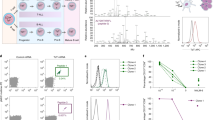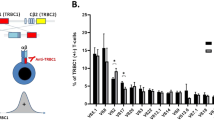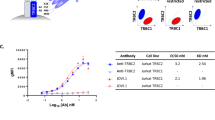Abstract
Patients with B-cell chronic lymphocytic leukemia (CLL) acquire an immunodeficiency with many characteristics similar to those of persons with inherited defects in the gene encoding the CD40-ligand (CD154). We found that the blood and splenic CD4+ T cells of patients with CLL failed to express surface CD154 after CD3 ligation. However, using an enzyme-linked immunosorbent assay (ELISA)-based quantitative competitive polymerase chain reaction (PCR), we noted that CD3 ligation could induce such T cells to express CD154 messenger RNA at levels similar to that of CD3-activated T cells from normal donors. Moreover, addition of increasing numbers of CLL B cells to activated normal donor T cells rapidly resulted in progressively greater down-modulation of CD154. Such down-modulation of CD154 could be blocked by addition of CD40 monoclonal antibody to cultures in vitro. We propose that leukemia cell-mediated down-modulation of CD154 on activated T cells accounts for some of the acquired immune defects of patients with CLL.
This is a preview of subscription content, access via your institution
Access options
Subscribe to this journal
Receive 12 print issues and online access
$209.00 per year
only $17.42 per issue
Buy this article
- Purchase on Springer Link
- Instant access to full article PDF
Prices may be subject to local taxes which are calculated during checkout
Similar content being viewed by others
References
Roy, M., Waldschmidt, T., Aruffo, A., Ledbetter, J.A. & Noelle, R.J. The regulation of the expression of gp39, the CD40 ligand, on normal and cloned CD49+ T cells. J. Immunol. 151, 2497–2510 (1993).
Castle, B.E., Kishimoto, K., Steams, C., Brown, M.L. & Kehry, M.R. Regulation of expression of the ligand for CD40 on T helper lymphocytes. J. Immunol. 151, 1777–1788 (1993).
Banchereau, J. et al. The CD40 antigen and its ligand. Annu. Rev. Immunol. 12, 881–922 (1994).
Clark, E.A. & Ledbetter, J.A. How B and T cells talk to each other. Nature 367, 425–428 (1994).
Van den Eertwegh, A.J. et al. In vivo CD40-gp39 interactions are essential for thymus-dependent humoral immunity. I. In vivo expression of CD40 ligand, cytokines and antibody production delineates sites of cognate T-B Cell interactions. J. Exp. Med. 178, 1555–1565 (1993).
Casamayor-Palleja, M., Khan, M. & MacLennan, I.C. A subset of CD4+ memory T cells contains preformed CD40 ligand that is rapidly but transiently expressed on their surface after activation through the T Cell receptor complex. J. Exp. Med. 181, 1293–1301 (1995).
Han, S. et al. Cellular interaction in germinal centers: Roles of CD40 ligand and B7-2 in established germinal centers. J. Immunol. 155, 556–567 (1995).
Aruffo, A. et al. The CD40 ligand, gp39, is defective in activated T cells from patients with X-linked hyper-IgM syndrome. Cell 72, 291–300 (1993).
Allen, R.C. et al. CD40 ligand gene defects responsible for X-linked hyper-IgM syndrome. Science 259, 990–993 (1993).
DiSanto, J.P., Bonnefoy, J.Y., Gauchat, J.F., Fischer, A. & de Saint Basile, G. CD40 ligand mutations in X-iinked immunodeficiency with hyper-IgM. Nature 361, 541–543 (1993).
Korthauer, U. et al. Defective expression of T-Cell CD40 ligand causes X-linked immunodeficiency with hyper-IgM. Nature 361, 539–541 (1993).
Grewal, I.S., Xu, J. & Flavell, R.A. Impairment of antigen-specific T-Cell priming in mice lacking CD40 ligand. Nature 378, 617–620 (1995).
Kipps, T.J. Chronic lymphocytic leukemia and related diseases. in William's Hematology. (eds. Beutler, E., Lichtman, M.A., Coller, B.S. & Kipps, T.J.) 1017–1039 (McGraw-Hill, Inc., New York, 1995).
Hamblin, T.J., Oscier, D.G. & Young, B.J. Autoimmunity in chronic lymphocytic leukaemia. J. Clin. Pathol. 39, 713–716 (1986).
Westbrook, C.A. & Golde, D.W. Clinical problems in hairy Cell leukemia: Diagnosis and management. Semin. Oncol. 11, 514–522 (1984).
Rosen, F.S., Cooper, M.D. & Wedgwood, R.J. The primary immunodeficiencies. N. Engl. J. Med. 333, 431–440 (1995).
Lucivero, G., Prchal, J.T., Lawton, A.R., Antonaci, S. & Bonomo, L. Abnormal T-Cell functions in B-Cell chronic lymphocytic leukemia do not imply T-lymphocyte involvement in the leukemic process: Report of a case with demonstrated “polyclonality” of T lymphocytes. J. Clin. Immunol. 3, 111–116 (1983).
Han, T. et al. Lack of autologous mixed lymphocyte reaction in patients with chronic lymphocytic leukemia: Evidence for autoreactive T-Cell dysfunction not correlated with phenotype, karyotype, or clinical status. Blood 60, 1075–1081 (1982).
Kay, N.E. & Kaplan, M.E. Defective T Cell responsiveness in chronic lymphocytic leukemia: Analysis of activation events. Blood 67, 578–581 (1986).
Kay, N.E. & Kaplan, M.E. Defective expression of T Cell antigens in chronic lymphocytic leukaemia: Relationship to T Cell dysfunction. Br. J. Haematol. 57, 105–111 (1984).
Ayanlar-Batuman, O., Ebert, E. & Hauptman, S.P. Defective interleukin-2 production and responsiveness by T cells in patients with chronic lymphocytic leukemia of B Cell variety. Blood 67, 279–284 (1986).
Fernandez, L.A., MacSween, J.M. & Langley, G.R. T Cell function in untreated B Cell chronic lymphocytic leukemia. Cancer 39, 1168–1174 (1977).
Platsoucas, C.D. et al. Defective spontaneous and antibody-dependent cytotoxicity mediated by E-rosette-positive and E-rosette-negative cells in untreated patients with chronic lymphocytic leukemia: Augmentation by in vitro treatment with interferon. J. Immunol. 125, 1216–1223 (1980).
Callery, R.T. et al. Functional abnormalities associated with T lymphocytes from patients with chronic lymphocytic leukemia. Clin. Immunol. Immunopathol. 17, 451–458 (1980).
Semenzato, G., Pezzutto, A., Agostini, C., Albertin, M. & Gasparotto, G. T-lymphocyte subpopulations in chronic lymphocytic leukemia: A quantitative and functional study. Cancer 48, 2191–2197 (1981).
Matutes, E., Wechsler, A., Gomez, R., Cherchi, M. & Catovsky, D. Unusual T-Cell phenotype in advanced B-chronic lymphocytic leukaemia. Br. J. Haematol. 49, 635–642 (1981).
Totterman, T.H., Carlsson, M., Simonsson, B., Bengtsson, M. & Nilsson, K. T-Cell activation and subset patterns are altered in B-CLL and correlate with the stage of the disease. Blood 74, 786–792 (1989).
Patel, H.R., Oshiba, A., Jeppson, J.D. & Gelfand, E.W. Differential expression of CD40 ligand on T Cell subsets: Implications for different roles of CD45RA+ and CD45RO+ cells in IgE production. J. Immunol. 156, 1781–1787 (1996).
Lotz, M., Ranheim, E. & Kipps, T.J. Transforming growth factor beta as endogenous growth inhibitor of chronic lymphocytic leukemia B cells. J. Exp. Med. 179, 999–1004 (1994).
van Kooten, C. et al. B cells regulate expression of CD40 ligand on activated T cells by lowering the mRNA level and through the release of soluble CD40. Eur. J. Immunol. 24, 787–792 (1994).
Grammer, A.C. et al. The CD40 ligand expressed by human B cells costimulates B Cell responses. J. Immunol. 154, 4996–5010 (1995).
Yellin, M.J. et al. CD40 molecules induce down-modulation and endocytosis of T cell surface T cell-B cell activating molecule/CD40-L. Potential role in regulating helper effector function. J. Immunol. 152, 598–608 (1994).
Storrie, B. & Edelson, P.J. Distribution of concanavalin A in fibroblasts: Direct endocytosis versus surface capping. Cell 11, 707–717 (1977).
Salisbury, J.L., Condeelis, J.S. & Satir, P. Role of coated vesicles, microfilaments and calmodulin in receptor-mediated endocytosis by cultured B lymphoblastoid cells. J. Cell Biol. 87, 132–141 (1980).
Ranheim, E.A. & Kipps, T.J. Activated T cells induce expression of B7/BB1 on normal or leukemic B cells through a CD40-dependent signal. J. Exp. Med. 177, 925–935 (1993).
Notarangelo, L.D., Duse, M. & Ugazio, A.G. Immunodeficiency with hyper-IgM (HIM). Immunodefic. Rev. 3, 101–121 (1992).
Rossi, E. et al. Zeta chain and CD28 are poorly expressed on T lymphocytes from chronic lymphocytic leukemia. Leukemia 10, 494–497 (1996).
Mizoguchi, H. et al. Alterations in signal transduction molecules in T lymphocytes from tumor-bearing mice. Science 258, 1795–1798 (1992).
Bowen, F., Haluskey, J. & Quill, H. Altered CD40 ligand induction in tolerant T lymphocytes. Eur. J. Immunol. 25, 2830–2834 (1995).
Hermann, P. et al. Expression of a 32-kDa ligand for the CD40 antigen on activated human T lymphocytes. Eur. J. Immunol. 23, 961–964 (1993).
Paulie, S. et al. A p50 surface antigen restricted to human urinary bladder carcinomas and B lymphocytes. Cancer Immunol. Immunother. 20, 23–28 (1985).
Ben-Aissa, H. et al. Human bladder cancer associated antigens: evaluation of antigenicity in TCC tissues of different grades and in normal urothelium. Anticancer. Res. 8, 443–449 (1988).
Hutchins, D. & Steel, C.M. Regulation of ICAM-1 (CD54) expression in human breast cancer cell lines by interleukin 6 and fibroblast-derived factors. Int. J. Cancer 58, 80–84 (1994).
Pammer, J. et al. CD40 antigen is expressed by endotheliai cells and tumor cells in Kaposi's sarcoma. Am. J. Pathol. 148, 1387–1396 (1996).
Borrow, P. et al. CD40L-deficient mice show deficits in antiviral immunity and have an impaired memory CD8+ CTL response. J. Exp. Med. 183, 2129–2142 (1996).
Stuber, E., Strober, W. & Neurath, M. Blocking the CD40L-CD40 interaction in vivo specifically prevents the priming of T helper 1 cells through the inhibition of interleukin 12 secretion. J. Exp. Med. 183, 693–698 (1996).
Author information
Authors and Affiliations
Rights and permissions
About this article
Cite this article
Cantwell, M., Hua, T., Pappas, J. et al. Acquired CD40-ligand deficiency in chronic lymphocytic leukemia. Nat Med 3, 984–989 (1997). https://doi.org/10.1038/nm0997-984
Received:
Accepted:
Issue Date:
DOI: https://doi.org/10.1038/nm0997-984
This article is cited by
-
The Current Treatment Landscape of Cutaneous Squamous Cell Carcinoma
American Journal of Clinical Dermatology (2023)
-
Activation and expansion of T-follicular helper cells in chronic lymphocytic leukemia nurselike cell co-cultures
Leukemia (2022)
-
Chronic lymphocytic leukemia cells acquire regulatory B-cell properties in response to TLR9 and CD40 activation
Cancer Immunology, Immunotherapy (2018)
-
Cutaneous squamous cell carcinoma of the scalp in the immunocompromised patient: review of 53 cases
Oral and Maxillofacial Surgery (2016)
-
Identification and characterization of distinct IL-17F expression patterns and signaling pathways in chronic lymphocytic leukemia and normal B lymphocytes
Immunologic Research (2015)



